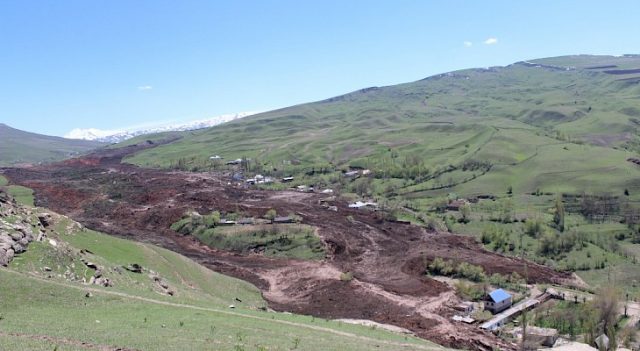3 May 2017
Kurbu-Tash and Ayu: the location of the two large landslides in Kyrgyzstan this weekend
Posted by Dave Petley
The Kurbu-Tash landslide
Yesterday I highlighted a huge landslide that occurred in Kyrgyzstan on Sunday. KABAR has a report today that provides details of its location, which is the village of Kurbu-Tash in Uzgen Region. Google Earth has good quality imagery of this area, which reveals why this area was prone to such an event:

Google Earth image of the site of the Kurbu-Tash landslide in Kyrgyzstan
.
From this perspective, to the right of the village of Kurbu-Tash there is a huge landslide scar extending two thirds of the way up the slope. Interestingly very little of the deposit from this landslide is evident on the imagery, suggesting that the debris has vacated the slope. This may imply a high mobility slide. To the left of the village is another landslide scar, which is much larger but possibly more degraded. The landslide on Sunday, shown below (image from KABAR) appears to have come from the left side of this area:-

The Kurbu-Tash landslide in Kyrgyzstan. Image from KABAR
.
The location of the Ayu landslide
Meanwhile, Elena Nikolaeva kindly contacted me to point out the location of the Ayu landslide, which killed 24 people in Kyrgyzstan on Saturday morning. This appears to be the area shown below, but sadly the image quality of Google Earth is too low to pinpoint it precisely:-

Google Earth imagery of the location of the Ayu landslide in Kyrgyzstan
.
This is an area that appears to be quite intensively farmed, but it is unclear as to whether this might have been a factor in the tragedy.
The government response to these landslide disasters
KABAR also reports that the President of Kyrgyzstan has ordered a long term response to the tragedy:
He noted that the causes and consequences of the disaster indicate that the emergency department needs to strengthen preventive measures, and local authorities to review methods of resettlement of people living in potentially dangerous areas in order to ensure their safety and avoid the severe consequences of natural disasters.
This is undeniably sensible, but requires a committed, scientifically-based hazard and risk analysis. That is not a trivial task.


 Dave Petley is the Vice-Chancellor of the University of Hull in the United Kingdom. His blog provides commentary and analysis of landslide events occurring worldwide, including the landslides themselves, latest research, and conferences and meetings.
Dave Petley is the Vice-Chancellor of the University of Hull in the United Kingdom. His blog provides commentary and analysis of landslide events occurring worldwide, including the landslides themselves, latest research, and conferences and meetings.